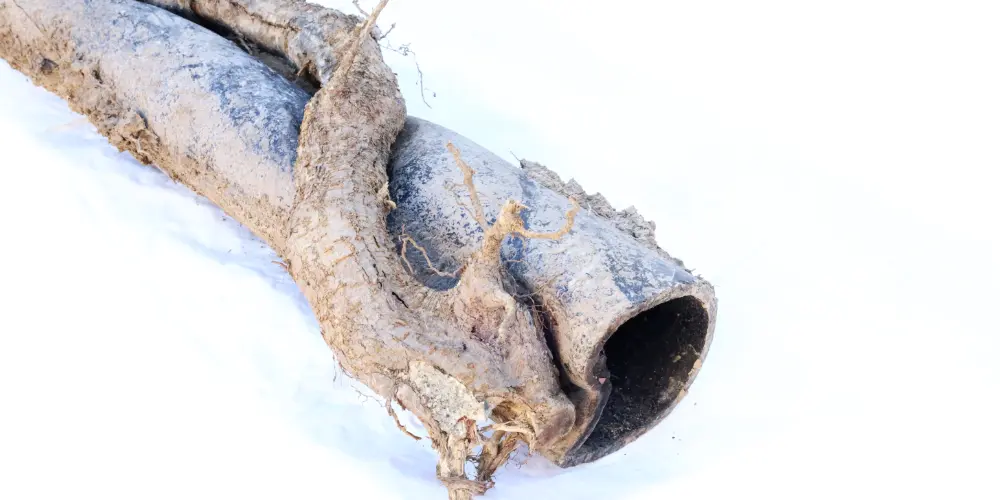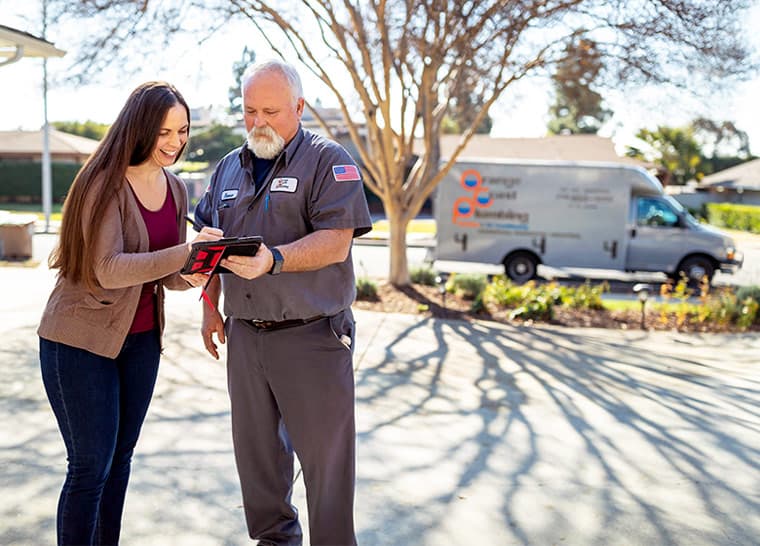One man’s trash is another man’s treasure.
For trees, that treasure is sewage.
Sounds disgusting, right? But think about it — sewage is packed with all those nutrients trees love. Your sewer pipe is like an all-you-can-eat buffet!
While your tree feasts, your plumbing suffers. Drains slow to a trickle or completely back up. Your toilet gurgles, overflows, or refuses to flush. You call the plumber, and — surprise! — he finds tree roots at the “root” of the problem.
What do you do now?
Understanding the Issue: Tree Roots in Sewer Lines
Before we go into possible solutions, here’s what you need to know:
Why Tree Roots Invade Sewer Lines
- Nature’s Quest for Water: Tree roots are naturally drawn to moisture. They seek out tiny cracks or loose joints in sewer pipes as a water source, invading them for nutrients and water.
- The Perfect Environment: Sewer lines provide a warm, oxygenated, and nutrient-rich environment for tree roots. Even the slightest breach can attract them. Once inside, they grow, expand, and exert pressure, damaging pipes and causing blockages.
Most Common Plants for Root Invasion in California
Some plants are more invasive than others. These water-loving species have aggressive root systems that can wreak havoc on your plumbing.
- Willow trees
- Chinese elms
- Fig trees.
- Poplar trees
- Maple trees
- Palm Trees
- Bamboo
- Oleander Shrubs
Warning Signs of Tree Root Intrusion
Recognizing the early clues of root invasion can save you from major plumbing headaches. Keep an eye out for these indications:
- Slow drains or recurrent blockages
- Gurgling sounds from drains or toilets
- Foul odors emanating from drains or the yard
- Soggy or unusually lush patches in your yard
- Frequent toilet backups
- Sinkholes in your yard
- Cracks in your home’s foundation
- Unusual plant growth (getting too lush or growing too fast)
What to Do When Tree Roots Invade Sewer Lines
Root invasions require prompt action, all involving a professional plumbing service.
1. Professional Inspection & Cleaning
A professional plumber with drain cameras can diagnose the location and extent of the root intrusion and recommend appropriate action.
- Hydro Jetting: High-pressure water jets clear tree roots from sewer lines, restoring flow.
- Root Cutting: Mechanical cutting tools can sever invading roots without damaging the pipes.
2. Pipe Relining
Your plumber might suggest pipe relining if the damage is moderate. A new lining is inserted inside the existing pipe, creating a “pipe within a pipe” resistant to tree root intrusion.
3. Pipe Bursting
Pipe bursting is a trenchless repair technique for severely damaged pipes. This method bursts the old pipe while simultaneously pulling a new one into place. The technique requires only two access holes, minimizing disruption to your home and yard.
4. Traditional Digging & Replacement
This approach is precisely what it sounds like — your plumber digs up the affected area, removes the root-infested pipe, and replaces it with a new one. It’s more disruptive to your beautiful lawn or garden, but sometimes it’s the most effective solution.
5. Chemical Root Killers
As a last resort, your plumber might suggest using chemical root killers. These products kill the invading roots inside the pipe and prevent new growth for a time. However, they should be used sparingly due to their adverse environmental impact.
Preventive Measures to Keep Roots at Bay
Prevention is key to avoiding recurring issues with tree roots:
- Strategic Planting: Avoid planting trees and shrubs with aggressive root systems near sewer lines.
- Regular Maintenance: Schedule inspections and proactive cleaning to prevent root intrusion.
- Barriers and Seals: Install physical barriers or seal pipe joints to deter root entry.
- Root Barriers: These metal, wood, or plastic barriers are buried to keep roots from growing towards the sewer lines. The depth and length of the barrier will depend on the species and maturity of the tree.
- Pipe Joint Seals: These metal or rubber seals are placed around pipe joints to prevent root infiltration.
- Sewer Safe Trees: Consider planting species with less aggressive root systems. Consult with a local nursery to help you choose the right trees for your area.
- Relocating Sewer Lines: This expensive undertaking could save you from recurrent plumbing issues in the long run.
- Regular Pipe Replacement: Old, deteriorating sewer pipes are more vulnerable to root intrusion. If your pipes are over 50 or corroded, you may need to replace them.
Sewer Line Repair in Orange County, CA
When it’s time to call the pros, count on Orange Coast Plumbing for all your plumbing needs, including:
- Sewer line inspection
- Hydro jet cleaning
- Pipe relining
- Trenchless repair
We serve all of Orange County, CA, and parts of LA County.
We’ve been in business since 1977. We charge reasonable rates and guarantee our work. Our plumbers are licensed, certified, trained in the latest plumbing methods, and available 24/7 for emergencies.
FAQs: Common Queries about Tree Roots in Sewer Lines
Q1: Can I tackle a root intrusion myself?
A: While DIY solutions exist, we advise consulting a professional for accurate diagnosis and safe, effective treatments.
Q: Are tree roots in sewer lines covered by insurance?
A: Coverage varies. Some policies might cover damages caused by tree roots, while others exclude them. Check with your insurance provider for clarification.
Q: How do I know if tree roots have damaged my sewer lines?
A: Look for warning signs, such as slow drains, foul odors, or sinkholes in your yard. If you suspect root intrusion, contact a professional plumber for an inspection.
Q: How can I tell if there are tree roots in my sewer lines?
A: Recurrent drainage problems like slow drains, gurgling sounds, or frequent backups can indicate root intrusion. Only a professional inspection can confirm it.
Q: Can tree roots break through PVC pipe?
A: Yes, despite being more resilient than clay or cast iron, PVC pipes are still susceptible to tree root invasion, especially at joints.
Q: Will a tree die after you cut its roots?
A: This varies depending on the tree species and the extent of root cutting. Some trees can survive despite significant root loss, while others may decline rapidly.
Q: How far should trees be planted from sewer lines?
A: As a rule of thumb, trees should be planted from sewer lines at a distance equivalent to their mature height. However, species with aggressive root systems may need more space.
Q: Is there a way to guarantee tree roots don’t grow toward sewer pipes?
A: While it’s impossible to control root direction entirely, strategic planting, regular maintenance, and installing root barriers can help keep roots from sewer lines.
Q: Do all trees have root systems that can damage sewer lines?
A: Not all trees pose a threat. Some species have less aggressive root systems that are less likely to invade sewer lines.
Q: How often should I have my sewer lines inspected?
A: We recommend an annual inspection to spot potential problems early. However, you may need more frequent checks if you have older pipes or trees close to your sewer line.
Q: What are the alternatives to chemical root killers?
A: Non-chemical alternatives include mechanical root cutting, hydro jetting, pipe relining, and pipe bursting. These methods physically remove or block the roots.


